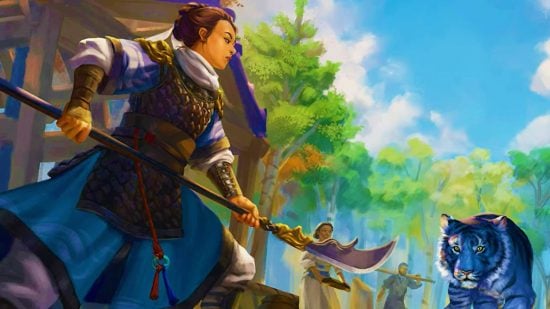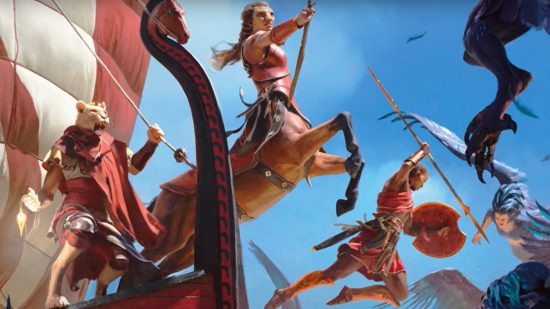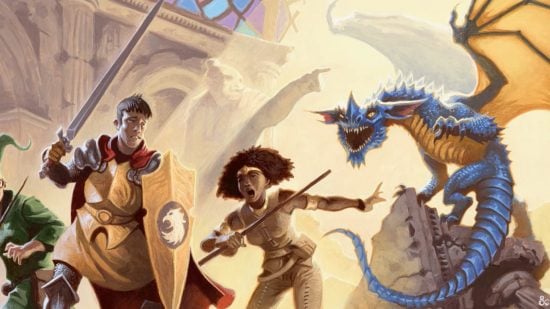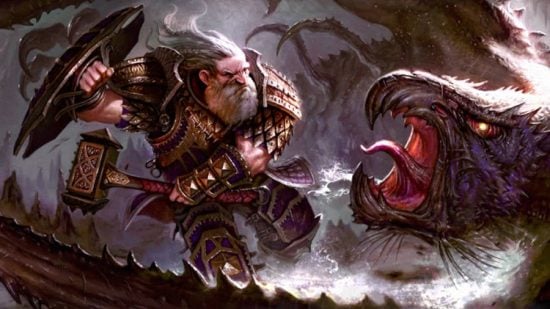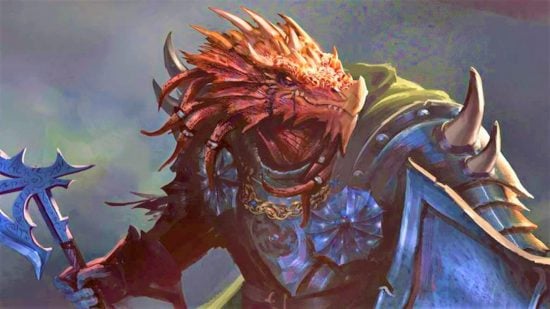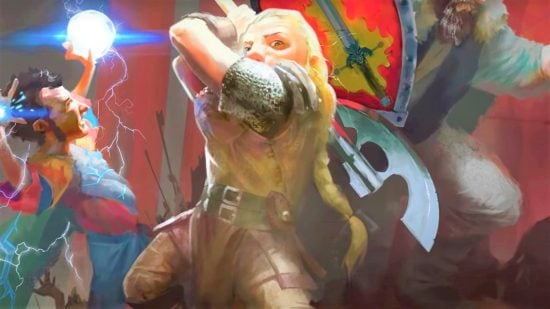Dungeons and Dragons players often call Fighters simplistic, but subclasses like the DnD Battle Master keep the class varied and versatile. Armed with a battalion of possible combat options, no two Battle Master 5e characters feel quite the same. And if you need advice on playing one, you’re in the right place.
Below you’ll find everything there is to know about this esteemed DnD Fighter subclass. We’ve detailed each DnD classes feature you’ll gain, and we recommend everything from DnD races to the best maneuvers for battle. The first stepping stone for your DnD character build can be found right here.
Here’s all you need to know about the DnD Battle Master 5e subclass:
Battle Master 5e features
Here are each of the Battle Master 5e features you’ll gain as your character levels up:
Combat Superiority
Level: Three / 10 / 15
The defining feature of a Battle Master is their ‘maneuvers’, as well as the combat dice you’ll spend to activate them. Combat Superiority gives you access to three of these unique battle tactics at level three, and you’ll learn two more at levels 10 and 15.
At level three, you have four superiority dice (each of which is a d8). You’ll gain one extra die at level seven and another at level 15. You can use one maneuver per attack, and you must spend a superiority die to use it. These are replenished on a short or long rest 5e.
Sometimes, a maneuver will prompt your enemy to make a saving throw. The difficulty class is calculated by adding your proficiency bonus and Strength or Dexterity modifier together, then adding eight to the final result.
We’ve talked a lot about the mechanics of maneuvers, but what can they actually do? Here’s a complete list:
Ambush 5e
As long as you’re not incapacitated, you can spend a superiority die and add its result to a Stealth or Initiative roll.
Bait and Switch 5e
On your turn, you can spend a superiority die to switch places with a willing creature within five feet. That creature can’t be incapacitated, and you need to spend five feet of movement for the switch to be successful. On the bright side, this move doesn’t trigger any attacks of opportunity.
After you’ve made the swap, roll the superiority die you spent. You can add this result to you or your swap-happy buddy’s armor class until the start of your next turn.
Brace 5e
If a creature you can see moves within reach of your melee DnD weapon, you can spend a superiority die to attack them as a reaction. You can also add the superiority die to the damage roll if your strike is successful.
Commander’s Strike 5e
When you take the Attack action, you can choose to forego an attack, spend a bonus action, and use a superiority die. In exchange, you grant a friendly creature who can see or hear you a free weapon attack. This counts as using their reaction, and you can add your superiority die to the attack’s damage roll.
Commanding Presence 5e
This maneuver lets you spend a superiority die and add the result to an Intimidation, Performance, or Persuasion check. Not so useful for hitting things, but perhaps a solid way to avoid a fight.
Disarming Attack 5e
When you hit a creature with a weapon attack, you can spend a superiority die to force your target to make a Strength saving throw. If it fails, the foe drops an object of your choice. You can also add the superiority die to the attack’s damage roll.
Distracting Strike 5e
If you successfully hit a creature with a weapon attack, you can spend a superiority die to give your allies advantage on the next attack against that target. The attack must be made by someone other than you before the start of your next turn. Also, you get to add that sweet superiority die to your initial attack’s damage roll.
Evasive Footwork 5e
You can spend a superiority die when moving to boost your armor class. Simply roll the die and add the result to your AC – this only lasts until you stop moving, however.
Feinting Attack 5e
To perform a Feinting Attack, spend one superiority die and a bonus action. You then gain advantage on your next attack roll against a creature of your choice that’s within five feet. The attack must be taken on your current turn, and the superiority die gets added to the damage roll if you manage to hit your target.
Goading Attack 5e
When you’re hit by a weapon attack, you can spend a superiority die to force your attacker to make a Wisdom saving throw. On a failed save, that foe has disadvantage on attack rolls against anybody that isn’t you until the end of your next turn.
Grappling Strike 5e
After landing a melee hit on a creature, you can spend a superiority die to try and use grapple 5e on the target as a bonus action. You can add your superiority die to the Athletics check you’ll make as part of the grapple.
Lunging Attack 5e
After making a melee weapon attack on your turn, you can spend a superiority die to increase the attack’s reach by five feet. And naturally, you can add the superiority die to a successful damage roll for this attack.
Maneuvering Attack 5e
After a successful weapon attack, you can spend a superiority die to add the die to the damage roll – and grant a friendly creature a unique reaction. This ally can move up to half its speed without triggering opportunity attacks, but only from the enemy you hit with your initial weapon attack.
Menacing Attack 5e
After a successful weapon attack against a creature, you can spend one superiority die to force the target to make a Wisdom saving throw. If they fail, they’re frightened until the end of your next turn.
Parry 5e
If another creature deals damage to you with a melee attack, you can spend a reaction and a superiority die to reduce the damage. Add the number rolled on your superiority die to your Dexterity modifier, and reduce the incoming damage by that much.
Precision Attack 5e
When you roll a weapon attack against a creature, you can spend a superiority die and add the result to the roll. This must be done before the effects of the attack are resolved, but you can choose to use the maneuver before or after the initial attack roll is made.
Pushing Attack 5e
Any time you hit a creature with a weapon attack, you can spend a superiority die to add it to the damage roll. If the target is Large or a smaller DnD size, it must also make a Strength saving throw. A failed save pushes them 15 feet away from you.
Quick Toss 5e
You can spend a superiority die to make a ranged thrown weapon attack as a bonus action. Drawing the weapon counts as part of the attack, and you’ll add your superiority die to the damage on a successful hit.
Rally 5e
Spend a bonus action and a superiority die to grant a friendly creature temporary hit points, equal to the superiority die roll plus your Charisma modifier.
Riposte 5e
If a creature misses you with a melee attack, you can spend a reaction and a superiority die to make your own melee weapon attack against them. The superiority die is added to the damage if you hit.
Sweeping Attack 5e
On a successful melee weapon attack against a creature, you can spend a superiority die to damage a second creature within five feet of your initial target. You use the original attack roll to determine whether you hit the second enemy, and a successful second attack deals damage equal to the number you roll on your superiority die. The same DnD damage type is used for both attacks.
Tactical Assessment 5e
You can spend a superiority die to add it to an Investigation, History, or Insight check.
Trip Attack 5e
When you hit a creature with a weapon attack, you can spend a superiority die to add it to the damage roll. Also, if the target is Large or smaller, it’s knocked prone on a failed Strength saving throw.
Student of War
Level: Three
You gain proficiency with a type of artisan’s tools (your choice).
Know Your Enemy
Level: Seven
If you spend one minute watching or interacting with a creature outside of combat, you can learn information about it from your Dungeon Master. The DM must tell you if the creature is better, equal, or worse than you in two of the following areas:
- Strength
- Dexterity
- Constitution
- Armor class
- Current hit points
- Class levels
- Fighter class levels
Improved Combat Superiority
Level: 10 / 18
Your superiority dice become d10s at level 10, and they’re upgraded to d12s from level 18.
Relentless
Level: 15
If you have no superiority dice left when you roll initiative, you automatically get one back.
Best Battle Master 5e maneuvers
You’ve got a lot of Battle Master maneuvers to choose from, so where do you start? Well, some among the bunch are obviously stronger than others.
Riposte is our favorite maneuver by a country mile. A free attack with boosted damage is simple, yes. But fifth edition is all about action economy, so an extra pot shot against your foes can be a game-changer.
We’re also a big fan of maneuvers that inflict conditions upon your enemies. Trip Attack is an easy way to give your party advantage against a fallen foe, and Menacing Attack gives the target disadvantage and some seriously limited movement options.
Best Battle Master 5e races
Thanks to the custom rules in Tasha’s Cauldron of Everything, any of the 5e races can have the DnD stats you need to play a Battlemaster. That being said, anyone not using those rules should focus on races that buff Constitution, Strength, or Dexterity (depending on how you build your Fighter).
In the Player’s Handbook, this leaves you with plenty of options, from Half-Orcs to most kinds of DnD Dwarf or 5e Elf. But there’s a reason the variant DnD Human remains the most popular race for Fighters. That free feat adds extra customization to an already pretty varied class and subclass.
Not sure the Battle Master is right for you? Here’s a ranked list of DnD Fighter subclasses for you to choose from. We can also point you to the best 5e feats and DnD backgrounds for your character.

